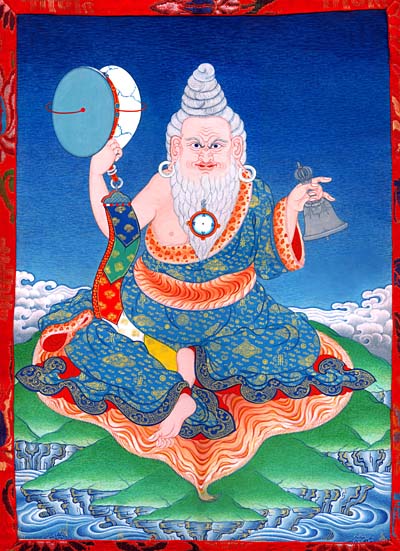
Rang-rig Togden
sang-yab of Jomo Pema ’ö-Zér
Rang-rig Togden’s full name was Rang-rig Trögyal Pawo (rang rig khro rGyal dPa bo). Khandro Déchen comments:
This beautiful Tibetan thangka painted by Kumar Lama shows Rang-rig Togden wearing a blue chuba trimmed with the skins of tigers and leopards. Although Rang-rig Togden’s chuba was trimmed with such furs – the actual chuba
would not have been embroidered with gold thread as shown here. The inclusion of gold thread is an honorific convention of Tibetan thangka painting, and
emphasises the quality of veneration rather than depicting how Rang-rig Togden actually dressed. He is shown sitting on an island which indicates that he spent his life as a reclusive hermit, as it was often the case that
a Lama such as Shabkar and many others would live on islands within large lakes in order to remain private from those who would come bearing continual gifts and requests for blessings. He is shown with a mélong braided into his beard in depiction of his practice of Dzogchen long-dé.
Ngak’chang Rinpoche comments:
Rang-rig Togden was a powerful gÇodpa who was born into the A-Kyong clan from Golok. As well as mastering gÇod, he specialised also in the subjugation practice of Chana Dorje (phyag na rDo rJe – Vajrapani), Tamdrin (rTa mGrin – Hayagriva), and
Khyung (Khyung – Garuda). Rang-rig Togden also
practised the Kha-khyab Rangdröl of Padma Düd’dül Rinpoche of Nyarong, which he had received from A’dzom Drukpa (A ’dzom brug pa gro ’dul do rJe, 1842-1924) at Tashi Dungkar Khyil (bKra shis dung dKar khyi). He had also received transmissions from
DoKhyentsé Yeshé Dorje (mDo khyen tse ye shes do rJe, 1800-1866), from whom he received the transmissions of his own gTérmas of
Pema Gyalpo.
Until meeting with Jomo Pema ’ö-Zér, Rang-rig Togden had been a wandering gÇodpa, but she instructed him in the practices of Dzogchen long-dé which she had received from her aunt Jomo Chhi’mèd Pema, and after that he had several visions of Yeshé Tsogyel, Tashi Chhi’drèn and Mandarava. They practised all their lives in caves and spent almost all their elder years in retreat.
